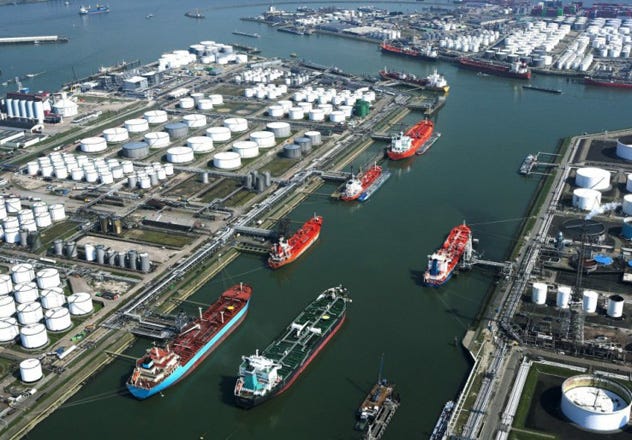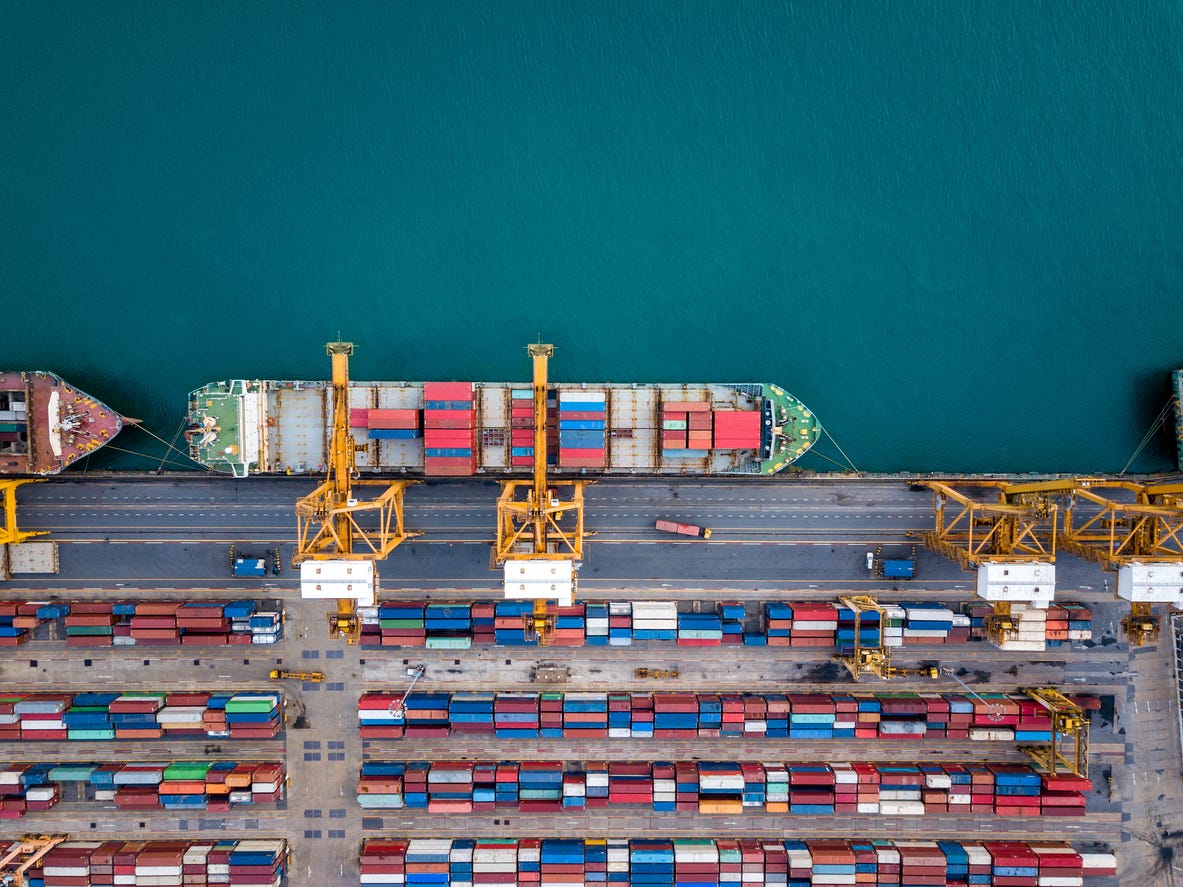Netherlands, Hong Kong, and the UAE: The US Trade Surplus Nations, the Modern Networked State and American Alliances
Netherlands, Hong Kong and UAE have two things in common: they are super trade hubs -- and the U.S runs a large trade surplus with them. On tariffs, networked states, U.S alliances, and the long game.
By now, we know President Trump’s view on trade deficits. He hates them, and claims that the “offending” countries are “ripping us off.” The top five biggest “offenders,” according to most recent data are China, Mexico, Vietnam, Ireland, and Germany.
Despite a raft of evidence that goods trade deficits are neither damaging nor surprising for a large consumption-driven, services-oriented economy, President Trump remains obsessed with these numbers, numerous accounts report.
His obsession led to the sweeping “Liberation Day” tariffs announced on April 2, as well as separate tariffs on steel, aluminum, and automobiles, with a separate round of tariffs aimed at China. These tariffs - even with most of the higher tariffs on a 90 day pause - are rocking markets, pushing global growth prospects downward, roiling supply chains, disrupting business forecasting, and slowing U.S growth.
But what about countries that find themselves in the opposite position? Countries that face a trade deficit with the United States? Or to put another way, countries in which the United States runs a trade surplus. There are, surprisingly, many of them: the U.S runs trade surpluses with more countries than it runs deficits, 132 to 101.
Still, the size of the trade imbalances overwhelm the number of countries and that’s why the U.S ran a $1.2 trillion goods trade deficit last year. (For a primer on why trade deficits should not alarm U.S leaders, see Noah Smith - Trade Deficits Do Not Make a Country Poorer).
But this is not yet another article about why trade deficits don’t matter. They can indeed matter, if they are handled badly by a country that does not possess the exorbitant privilege of holding the global reserve currency or a less diversified economy, but, and here’s the key point: they have not mattered a great deal in the United States - a country that has run trade deficits every quarter (except one) since 1976, according to Peterson Institute economist Maurice Obstfeld.
Now, let’s look at the countries/regions where the U.S runs a goods trade surplus. The top three are: Netherlands, Hong Kong and the United Arab Emirates. The Motley Fool has a good run down of all countries trade deficits/surpluses with the United States.
All three have something in common. They are all global trade hubs that have leveraged a depleting resource - their geography - to build powerful platforms for trade. They all run busy, cutting edge sea ports that trade with the world, as well as major air cargo hubs in some of the busiest airports in the world.
I recently visited Jebel Ali port in Dubai - a dizzying monument to globalization, and destination for a large share of US exports to the UAE. See my dispatch below
All three are built for trade, for connectivity, for globalization.
As such, with small populations, Netherlands, Hong Kong and the UAE conduct an outsized percentage of world trade (more on that below).
Should those three countries view the U.S as "ripping them off?” Obviously not. They understand that trade is not a zero-sum game, and the real winners are those states that build powerful, resilient, diversified trading relationships, fueled by deep investments in the infrastructure of connectivity. The UAE, in particular, is doubling down on trade, signing a dizzying array of free trade agreements with some 26 countries.
Of course, when it comes to Netherlands and the UAE, there’s another aspect to the story that goes beyond trade. The United States has played a vital role as a security guarantor for both nations, either via NATO or through US forward presence in the Middle East. (Interestingly, the U.S runs a trade surplus with the Middle East and North Africa region as whole.)
Let’s look at the numbers of these three U.S trade surplus countries.
US Trade Surplus
Netherlands - +$55.5 Billion
Hong Kong - +$21.9 Billion
United Arab Emirates - +$19.5 Billion
Source: USTR and U.S Department of Commerce
The U.S trade surplus with Netherlands is by far the largest at $55.5 billion. The Dutch state buys a good deal of U.S petroleum - both crude oil and products. These products land in Rotterdam’s massive port, and most of it is re-exported elsewhere, to Europe, Asia, even Africa. The Netherlands also buys a wide range of technical equipment, pharmaceuticals, and electronics. While the U.S runs a deficit with the EU as a whole, the Netherlands is an outlier.
As for Hong Kong, the U.S surplus is driven by sales of electrical equipment, metals, precious stones, and machinery. Given Hong Kong’s role as a trade hub, it is likely that some of the U.S goods are re-exported elsewhere, including to China.
The UAE, a global trade powerhouse, last year conducted more than $1 trillion in world trade. It sells virtually no oil to the United States, but buys billions of dollars in aircraft, vehicles, machinery, and electrical equipment - and has become a global re-export hub.
Trade has paid off well for all three states. Of course, Hong Kong is no longer an independent state, and the heavier hand of the state in Beijing has diminished, rather than enhanced, its role as a major trade hub, but it is still one of the largest trading states per capita in the world.
Consider the following back-of-the-envelope calculations I made by looking at trade numbers from the World Trade Organization and UN population numbers.
Netherlands, Hong Kong and the UAE collectively account for about 8.2% of world trade, but they only account for about .447% of the world population.
Here’s the breakdown:
Netherlands (pop: ~18 million) - 3.7% of world trade
Hong Kong (pop: ~7.3 million) - 2.5% of world trade
UAE (pop: ~11 million) - 2% of world trade
Source: WTO
These three trading nations punch far above their weight. Their 8.2% of world trade stands toe-to-toe with the total combined trade of South Asia and Africa, which collectively account for some 40% of the global population. Yes, that’s right. Countries with .44% of the world’s population conduct almost as much trade with the world as countries with 40% of the world’s population.
That might be the real lesson in these three U.S trade surplus countries. Trade can help countries punch far above their weight and be a powerful force multiplier for prosperity.
But there’s another lesson here, one that geopolitical strategist Joshua Cooper Ramo notes in his book, The Seventh Sense. He writes: “we are now in the earliest stages of a shift that promises to be still more consequential than the one that enlightened and industrialized our world over several centuries after the Dark Ages.” He points to the power of networks and connectivity as vital to the future of nations, firms, and individuals. “We experience power through networks now, as once we experienced it through brick-bound institutions such as universities or military headquarters or telephone companies.”
The more networked nations succeed. The ones off the grid lag behind. The UAE and the Netherlands are highly networked nations, in terms of their trade, diplomatic, financial and defense partnerships. Ever since China took more control over Hong Kong, its network density has arguably diminished, and it has become more dependent on one power, but it remains an important node of air and sea connectivity on key trade routes.
There are geopolitical implications here. We hear a great deal these days about a multi-polar world, but there is something vague and amorphous about that description. For so-called middle powers in this multi-polar world, they prefer to call themselves “multi-aligned.” Why play in one camp alone, when each camp - or each country or city - can offer something useful?
There’s a growing body of intellectual thinking around this idea, as I noted in a Forbes piece on the topic. Narayanappa Janardhan, an Abu Dhabi-based scholar with the Anwar Gargash Diplomatic Academy, told me: “The multipolar world we knew has now shifted. It is no longer conditioned by superpowers alone. It is just as likely to be conditioned by middle and smaller powers, who prefer multi-alignment.”
Mohammed Baharoon, Director-General of the Dubai Public Policy Research Center (b’huth), wrote in an essay for the Middle East Institute in Washington. “The world order is not uni-, bi-, or even multipolar, but rather networked.”
The always insightful Michael O’Sullivan, former chief economist at Credit Suisse, and I have been toying with the idea of a Fourth Pole. He explains it well in a Forbes column:
The second element worth commenting on is the idea of ‘The Fourth Pole’. I have written on this in the last year, and the idea is that in a multipolar world made up of three ‘poles’ (US, EU and China) there is room for a fourth pole made up of India, the Gulf States and other players across the ‘region’ (which we could define as those countries a five hours flight away from the UAE, which includes some 2.4 billion people across Asia, Africa, Southeast Europe and the Eastern Mediterranean).
The notion of the ‘Fourth Pole’ is gathering pace around the very close relationship between the UAE and India (the very popular Hindu Temple in Abu Dhabi is just one sign), and the web of trade, finance and infrastructure deals they are engaging in across the region. This relationship may not ultimately become as deep as that of the EU countries, but it is beginning to look like a modern version of the ‘Coal and Steel’ community. The risk however, is that they overbuild capacity in the face of a forthcoming economic shock or recession.
Mike and I are exploring this idea together (more on it soon). It is rooted in the notion that networks and alliances are powerful force multipliers, and “a Fourth Pole” may be emerging of states eager to accelerate trade, increase foreign direct investment, lower regulatory barriers, and cross-fertilize ideas for development in similar settings. They are doing so across a vast and rapidly growing consumer market.
It would not be wise for any grouping - however loose - to declare themselves a geopolitical “camp,” but as network densities thicken, there will inevitably be some geopolitical ramifications. Note to new BRICS members: don’t get sucked into geopolitical fights; be relentlessly geo-economic.
Let’s not forget that the United States - even amid all of the talk of protectionism and tariff wars - remains a highly networked nation. It’s the world’s second largest trading nation that attracts more foreign direct investment and foreign portfolio investment than any other nation. It’s also a member of a powerful - albeit weakened - security alliance, NATO, and no other nation has such deep military partnerships around the world. In fact, several China scholars have told me over the years that if Chinese President Xi Jinping fears anything, it is America’s powerful network of alliances worldwide, including in his own Asian backyard.
Now, it’s no secret that those alliances are strained as a result of recent actions by the White House. Rather than considering alliances as a “drag” on America, it would be better to view them the way social media companies view users: the more the better, and the deeper engagement, the higher returns.
It may also be hard to believe given that we have become so accustomed to America’s heft, but it, too, punches above its weight. With roughly 4% of the world’s population, the U.S accounts for about a quarter of the world’s output, about 12-13% of world trade, roughly 24% of global FDI inflows, and some 45% of global equity market capitalization (with a good chunk of that from foreign investors). China and the EU lag far behind the U.S on total market capitalization and FDI inflows, though both slightly edge the U.S on trade.
Here’s the full picture on U.S trade. All told, the U.S accounts for about 12-13% of global trade, with trade in goods and services exceeding $7 trillion. The U.S is also by far the largest services exporter to the world, tempering its goods deficit.
This from the Bureau of Economic Analysis:
For 2024, the [U.S] goods and services deficit was $918.4 billion, up $133.5 billion from $784.9 billion in 2023. Exports were $3,191.6 billion, up $119.8 billion from 2023. Imports were $4,110.0 billion, up $253.3 billion from 2023.
Ironically, one way to minimize deficits is for American companies to sell more goods abroad. This would involve more globalization, not less. President Trump has repeatedly said that the world does not buy enough U.S goods. If he got his wish, the world would see an acceleration in globalization, not a deceleration.
Recall that in 2020 the US-China trade deal did not isolate China. In fact, had the deal been honored, the U.S would have been more integrated with China, not less. China pledged to buy at least $200 billion more in U.S. goods and services over 2020–2021 compared to 2017 levels. That’s a lot of oil, soybeans, pork, manufactured goods, and services heading from the U.S to China. This was not a de-coupling effort, but a possible revival of Chimerica.
Post-script: Where are We Headed?
I recently spoke to a well-connected Washington insider, the kind of guy who gets paid a great deal by companies to interpret U.S policies. He had just come from a round of meetings on Capitol Hill with members of Congress. After coming down the mountain from “The Hill,” I asked him to share his pearls of wisdom
His response?
“No one know what’s going on. There is no memo. There is no playbook. Things can change, and change fast. So, fasten your seat belt.”
I wish I had more clarity than that for you. That’s why following the long game is always useful. One long game lesson: the most networked nations (yes, including the U.S) tend to outperform those that lag behind.
You can't cross the sea merely by standing and staring at the water.
Rabindranath Tagore
We must, indeed, all hang together or, most assuredly, we shall all hang separately.
Benjamin Franklin









